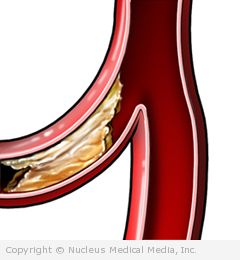Arteriogram
(Arteriography)
Arteriogram – Definition
An arteriogram is a test that allows a doctor to see the arteries on an x-ray. A contrast dye is injected into the arteries to make them visible. The test makes images that can be used to diagnose and treat problems in the arteries.
Arteriogram – Reasons for Test
An arteriogram is done to check the arteries for narrowing, bulging, or blockages. These could be signs of disease.
This test could be done to diagnose conditions such as:
- Peripheral arterial disease (PAD) — blockages in the arteries in your arms or legs
- Aneurysm — bulging of the arteries
- Vascular malformation — problems in the structure of the arteries
Sometimes, the doctor may treat problems found during the arteriogram. The doctor may dissolve a clot or do angioplasty with or without stenting.
Arteriogram – Possible Complications
Problems from the procedure are rare, but all procedures have some risk. Your doctor will review potential problems, like:
- Bruising or infection at the puncture site
- Bleeding, pain, or swelling where the catheter was inserted
- Allergic reaction to the contrast dye
- Damage to the blood vessels during the procedure (which may require surgery)
- Heart attack, stroke, or death (in rare cases)
Arteriogram – What to Expect
Prior to Procedure
At your appointment before the test, your doctor will likely:
- Do blood tests.
- Do a thorough physical examination.
- Ask about:
- Your medical history
- Medicines you take
- Allergies
- Whether you are pregnant or trying to get pregnant
- Your medical history
- Medicines you take
- Allergies
- Whether you are pregnant or trying to get pregnant
In the days before your procedure, you will need to:
- Arrange for a ride to and from the procedure.
- Follow your doctor’s instructions. You may need to make changes in your eating and drinking habits.
- Talk to your doctor if you take any medicines, herbs, or supplements.
- You may need to stop taking some medicines up to one week before the procedure, like:
- Aspirin and other nonsteroidal anti-inflammatory drugs (eg, ibuprofen, naproxen)
- Blood-thinning drugs, such as and warfarin (Coumadin)
- Anti-platelet drugs, such as clopidogrel (Plavix)
Do not eat or drink anything after midnight the night before your procedure.
Arteriogram – Anesthesia
You will have an IV (a needle in your arm) placed to give you medicines. These medicines will make you feel sleepy and comfortable.
Arteriogram – Description of the Procedure
For this procedure, you will have a catheter (small tube) placed in your groin or elbow (depending on which arteries the doctor needs to see) so that the doctor can inject the contrast dye. The skin where the catheter will be placed will be cleaned. The doctor will numb the area with a local anesthetic and make a tiny cut. The doctor will then insert a hollow needle into the artery. A thin wire will be placed into the artery. The catheter will be threaded over the wire, and the wire will be removed.
The doctor will use the catheter to inject a contrast dye into your artery. The dye may cause you to feel warm or flushed for a few moments. The doctor will take x-rays to see how the contrast dye is moving through your arteries. You will need to lie still to prevent blurry images.
Arteriogram – How Long Will It Take?
About one hour
Arteriogram – Will It Hurt?
Although the procedure is not painful, you may feel:
- A brief sting when local anesthesia is injected
- Pressure when catheter is inserted
- Hot and flushed when contrast dye is injected
Arteriogram – Post-procedure Care
After the test, the catheter will be removed. The IV will also be removed from your arm.
At the Care Center
Immediately following the procedure:
- You will need to be monitored for about six hours.
- The doctor or a nurse may press on the insertion site for 10-20 minutes to stop the bleeding.
- You will need to keep the arm or leg where the catheter was inserted straight. This will minimize bleeding.
- You will be encouraged to drink a lot of fluids to flush the contrast material from your system.
At Home
When you return home, take these steps:
- Follow your doctor’s instructions on cleaning the incision site.
- Ask your doctor about when it is safe to shower, bathe, or soak in water. Also ask your doctor when you can resume lifting heavy objects.
- You may eat normally. Continue to drink plenty of fluids for 1-2 days.
- For at least 12 hours, avoid strenuous activities like climbing stairs, driving, or walking.
- Be sure to follow all of your doctor’s instructions.
Arteriogram – Call Your Doctor
Call your doctor if any of these occurs:
- Signs of infection, including fever and chills
- Redness, swelling, increasing pain, excessive bleeding, or any discharge from the injection site
- Extreme sweating, nausea, or vomiting
- Extreme pain, including chest pain
- Leg or arm feels cold, turns white or blue, or becomes numb or tingly
- Difficulty breathing
- Any problems with your speech or vision
- Facial weakness
In case of an emergency, call for medical help right away.

